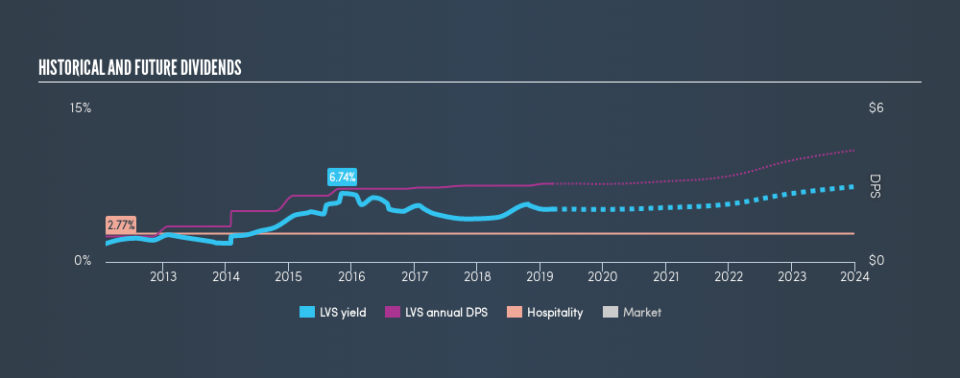4 Days Left Until Las Vegas Sands Corp. (NYSE:LVS) Trades Ex-Dividend

On the 28 March 2019, Las Vegas Sands Corp. (NYSE:LVS) will be paying shareholders an upcoming dividend amount of US$0.77 per share. However, investors must have bought the company’s stock before 19 March 2019 in order to qualify for the payment. That means you have only 4 days left! Is this future income a persuasive enough catalyst for investors to think about Las Vegas Sands as an investment today? Below, I’m going to look at the latest data and analyze the stock and its dividend property in further detail.
View our latest analysis for Las Vegas Sands
How I analyze a dividend stock
Whenever I am looking at a potential dividend stock investment, I always check these five metrics:
Is it the top 25% annual dividend yield payer?
Has it consistently paid a stable dividend without missing a payment or drastically cutting payout?
Has dividend per share amount increased over the past?
Can it afford to pay the current rate of dividends from its earnings?
Based on future earnings growth, will it be able to continue to payout dividend at the current rate?
How does Las Vegas Sands fare?
The current trailing twelve-month payout ratio for LVS is 98%, meaning the dividend is not sufficiently covered by its earnings. In the near future, analysts are predicting a more sensible payout ratio of 86%, which, assuming the share price stays the same, leads to a dividend yield of 5.4%. In addition to this, EPS should increase to $3.16, meaning that the lower payout ratio does not necessarily implicate a lower dividend payment.
When considering the sustainability of dividends, it is also worth checking the cash flow of a company. A business with strong cash flow can sustain a higher divided payout ratio than a company with weak cash flow.
If dividend is a key criteria in your investment consideration, then you need to make sure the dividend stock you’re eyeing out is reliable in its payments. The reality is that it is too early to consider Las Vegas Sands as a dividend investment. It has only been consistently paying dividends for 7 years, however, standard practice for reliable payers is to look for a 10-year minimum track record.
In terms of its peers, Las Vegas Sands generates a yield of 5.2%, which is high for Hospitality stocks.
Next Steps:
If Las Vegas Sands is in your portfolio for cash-generating reasons, there may be better alternatives out there. However, if you are not strictly just a dividend investor, the stock could still offer some interesting investment opportunities. Given that this is purely a dividend analysis, I urge potential investors to try and get a good understanding of the underlying business and its fundamentals before deciding on an investment. I’ve put together three fundamental aspects you should further examine:
Future Outlook: What are well-informed industry analysts predicting for LVS’s future growth? Take a look at our free research report of analyst consensus for LVS’s outlook.
Valuation: What is LVS worth today? Even if the stock is a cash cow, it’s not worth an infinite price. The intrinsic value infographic in our free research report helps visualize whether LVS is currently mispriced by the market.
Dividend Rockstars: Are there better dividend payers with stronger fundamentals out there? Check out our free list of these great stocks here.
We aim to bring you long-term focused research analysis driven by fundamental data. Note that our analysis may not factor in the latest price-sensitive company announcements or qualitative material.
If you spot an error that warrants correction, please contact the editor at editorial-team@simplywallst.com. This article by Simply Wall St is general in nature. It does not constitute a recommendation to buy or sell any stock, and does not take account of your objectives, or your financial situation. Simply Wall St has no position in the stocks mentioned. Thank you for reading.

